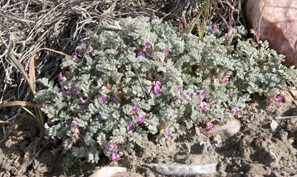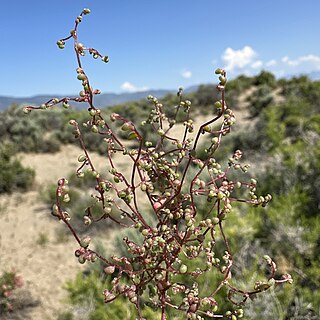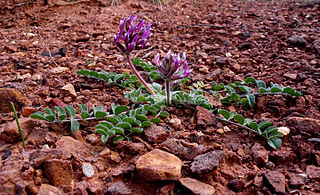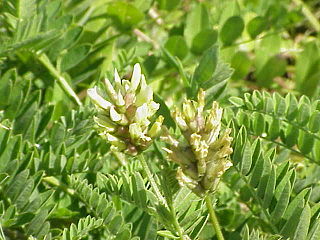The conservation status of a group of organisms indicates whether the group still exists and how likely the group is to become extinct in the near future. Many factors are taken into account when assessing conservation status: not simply the number of individuals remaining, but the overall increase or decrease in the population over time, breeding success rates, and known threats. Various systems of conservation status are in use at international, multi-country, national and local levels, as well as for consumer use such as sustainable seafood advisory lists and certification. The two international systems are by the International Union for Conservation of Nature (IUCN) and The Convention on International Trade in Endangered Species of Wild Fauna and Flora (CITES).

Astragalus canadensis is a common and widespread member of the milkvetch genus in the legume family, known commonly as Canadian milkvetch. The plant is found throughout Canada and the United States in many habitats including wetlands, woodlands, and prairies.

Astragalus pycnostachyus var. lanosissimus, the Ventura marsh milk-vetch, is a short-lived, herbaceous perennial in the pea family Fabaceae,
Astragalus anxius is a rare species of milkvetch known by the common names troubled milkvetch and Ash Valley milkvetch. It is endemic to northern Lassen County, California, where it is critically imperiled. It was formally described in 1992.

Astragalus brauntonii is a rare species of milkvetch known by the common name Braunton's milkvetch. It is endemic to California, where it is known from fewer than 20 extant occurrences in the hills and mountains surrounding the Los Angeles Basin in Southern California, as well as an isolated population in northern Baja California. This is a federally listed endangered species in the United States.

Astragalus deanei is a rare species of milkvetch known by the common name Dean's milkvetch, or Deane's milkvetch. It is endemic to southern San Diego County, California, where it grows on the slopes of the Peninsular Ranges between El Cajon and Tecate.

Astragalus pycnostachyus is a species of milkvetch known by the common name marsh milkvetch. It is endemic to the coastline of California, where it grows in wet saline habitat such as marshes.

Astragalus zionis is a species of legume known by the common name Zion milkvetch. It is one of the earliest flowers to bloom in Zion canyon. First described by botanist Marcus E. Jones in 1895, the species has also been placed in the defunct genus Xylophacos under the name Xylophacos zionis. The variety Astragalus zionis var. vigulus, the guard milkvetch, was described by Stanley Welsh in 1993.

Astragalus anserinus, also called the Goose Creek milkvetch, is a member of the genus Astragalus that is listed as a candidate species under the Endangered Species Act. It grows in a 10-square-mile (26 km2) area of the Goose Watershed of the Upper Snake Basin in Idaho, Nevada and Utah.

Micromonolepis pusilla, is the only species of the genus Micromonolepis in the flowering plant family Amaranthaceae, known by the common names small povertyweed and red povertyweed. It is native to the Western United States, including the Great Basin and surrounding areas, where it grows in sandy scrub, dry valleys, playas, and other open habitat. It is a somewhat fleshy annual herb producing a branching, slender stem that has a mealy whitish texture when young and turns dull to bright red with age, losing its grainy coat. It grows up to 14 to 20 centimeters tall. The thick oblong leaves are up to a centimeter long. Clusters of 1 to 3 minute flowers appear in the leaf axils, each flower made up of 3 tiny sepals.

Astragalus cremnophylax is a rare species of milkvetch known by the common names sentry milkvetch and cliff milkvetch. It is endemic to Arizona, where the three varieties grow in three separate locations. The rarest variety, var. cremnophylax, is a federally listed endangered species which grows only on the rim of the Grand Canyon. The two other varieties are known from the Buckskin Mountains and Marble Canyon.

Astragalus desereticus is a rare species of milkvetch known by the common name Deseret milkvetch. It is endemic to Utah County, Utah, where it is known from only one population. It was thought to be extinct until 1981 when this population was discovered. The population contains 5,000 to 10,000 plants on an area of land covering less than 300 acres. It is vulnerable to damage from grazing cattle, which eat the plant and trample the soil, and from development and erosion. This is a federally listed threatened species.

Astragalus holmgreniorum is a rare species of milkvetch known by the common names Holmgren milk-vetch and paradox milk-vetch. It is native to a tiny section of desert shrub woodland on the border between Utah and Arizona, in the far northern Mojave Desert. There are six populations remaining. It is a federally listed endangered species.

Astragalus osterhoutii, or the Osterhout milkvetch or Kremmling milkvetch, is an endangered species of milkvetch, discovered and collected in 1905 at Sulfur Spring in Grand County Colorado by Colorado botanist George Everett Osterhout for which the plant was named. It is found in the U.S. state of Colorado, in a 13 kilometres (8.1 mi) radius near the town of Kremmling.

Astragalus phoenix is a rare species of milkvetch commonly known as Ash Meadows milkvetch. It is mostly found in Nye County, southwestern Nevada.

Astragalus cicer, the chickpea milkvetch, chick-pea milk-vetch or cicer milkvetch, is a perennial flowering plant native to Eastern Europe, popularized and subsequently transported to areas in Southern Europe, North America, and South America. It produces pods that resemble those of chickpeas. Its flowers are usually of pale yellow tint, and attract bumble or European honey bees for pollination. Growth often exceeds 0.6 meters, up to a height of 1 meter in length.

Astragalus limnocharis var. montii, synonym Astragalus montii, is a rare variety of flowering plant in the legume family. It is known by the common name Monti's milkvetch. It is endemic to Utah in the United States, where there are only three known populations. Under the synonym A. montii, it is a federally listed threatened species of the United States.

Astragalus microcymbus is a species of flowering plant in the legume family known by the common name skiff milkvetch. It is endemic to Colorado in the United States, where it is known from Gunnison County and the edge of Saguache County. It was discovered in 1945 by Rupert Barneby, a British botanist. Currently, skiff milkvetch is experiencing population declines and is listed as a Tier 1 species in the Rare Plant Addendum to the Colorado State Wildlife Action Plan.
Astragalus leptaleus is a species of flowering plant in the legume family known by the common name park milkvetch. It is native to the Rocky Mountains of the United States, where it occurs in Idaho, Montana, Wyoming, and Colorado.

Astragalus molybdenus is a species of flowering plant in the legume family known by the common names Leadville milkvetch and molybdenum milkvetch. It is endemic to Colorado in the United States. If the separate species Astragalus shultziorum and Astragalus lackschewitzii are included in A. molybdenum the range expands into Wyoming and Montana.


















